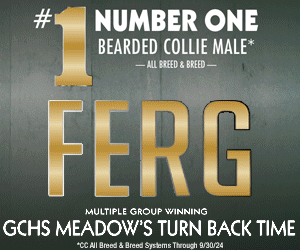Prioritizing Problems in Judging Bloodhounds
by Anne Legge
This discussion was prompted by a sweepstakes judge’s request for comments on the strengths and weaknesses of the breed. Serious Problems concern structure, function, and the hallmark head. Less Serious Problems and Minor Faults focus on aspects of breed type. There are NO disqualifications in the Bloodhound Standard. Judges should consider the ideal and penalize departures to the extent of deviation.
Serious Problems
Lack of Athleticism. Bloodhounds must have the stamina to follow a rugged trail for miles under all sorts of conditions. They need a deep keel, well sprung ribs, and a firm topline. They need bone and substance, strength, muscle, balanced angulation, and well knuckled up feet. They are built for endurance, not to race showily around a ring.
Faulty Front Assembly. The long neck must flow smoothly into muscular shoulders that are well laid back with sufficient prosternum and a deep keel. All these go together and are of utmost importance to the working hound.
Lack of Strong, Deep Loin. The mature body should be deep throughout its length with little or no tuck-up, built for stamina not speed.
Incorrect Head. The Standard is quite specific about the head, which is both functional and a hallmark of the breed. It should be long in proportion to the body; narrow in proportion to length; 12 inches long in dogs, 11 inches in bitches; muzzle at least as long as back skull; having the appearance of being flattened at the sides and nearly equal in width throughout its length; long, low-set, thin ears; square lip; large, open nostrils; nearly parallel head planes; and prominent occipital peak.
Too Large. Like many other breeds, Bloodhounds are getting larger. The Standard says the greater heights and weights are to be preferred provided that quality and proportion are also combined. However the top figures mentioned are 27 inches and 110 pounds for dogs and 25 inches and 90 pounds for bitches. They must be able to do their work, and sometimes that means being helped over a fence.
Incorrect Silhouette. The Bloodhound should not be square. “Stands over more ground” means rectangular or off-square.
Too Much or Too Little Skin. Bloodhounds need the pendulous ears and superabundant skin on their head and neck to stir up scent particles and protect their eyes. Excessive skin elsewhere, draping in folds on the thighs and over the base of the tail, is an invitation to bacteria and yeast. Penalize a bad smelling hound.
Faulty Bite. Although the bite is not important to the working function, the Standard is specific: scissors bite preferred, level bite accepted. Check the incisors and penalize undershot and overshot bites as well as dirty or unhealthy teeth.
Bold or Unhealthy Eyes. Bloodhound eyes seem to puzzle judges. The eyes are deeply sunk. Because of the loose skin, the eyelids assume a diamond or lozenge shape, and a pink haw is often visible. A round eye causes an uncharacteristic bold expression. Do not fault somewhat loose eyelids unless the eye appears weepy or unhealthy.
Minor Faults: Consider these aspects but remember that there are no disqualifications.
Excessive White. The Standard permits a small amount of white on the chest, feet, and tip of stern. Judges must determine what is a “small amount” and consider the relation of white markings to function.
Incorrect Stern Set and Carriage. A stern that is down or carried too gaily is a barometer of mood and an aspect of breed type, not function. Consider the whole hound. However, if something really bothers you, you may decide to fault it.
Not Addressed by the Standard: Length of leg in relation to height; prosternum; coat length, texture, and waviness; nose color
Strengths
Temperament is likely to be good in today’s bloodhounds, “neither quarrelsome with companions nor with other dogs.” The Standard says “somewhat shy,” but “reserved” would be a more accurate descriptor. The late Douglas Appleton (UK) says that “shy” means “the hound is sufficient unto himself unless he knows you.” Approach tactfully, not tentatively, speak to them and let them smell your hand.
When you see a good Bloodhound, you will know it because of the hallmark head, affable demeanor, substance, balance, athleticism, and coordination.
Short URL: https://caninechronicle.com/?p=47724
Comments are closed














